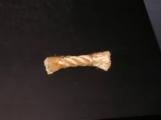1
This picture was taken in one of the segration cells. Note the name carved into the wall.7 September 2004
668 Brunswick Street, Fredericton, N.B
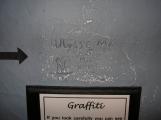
2
Graffiti - If you look closely you can see writing in the walls and the door of the dungeon. With so little to work with it's difficult to imagine what materials were used to carve out their names in 20-inch thick granite walls.3
Pair of jeans found under the floorboards during renovations to the jail20 September 2004
668 Brunswick Street, Fredericton, N.B

4
Prisoners wore jeans and a t-shirt. This pair of bell-bottom jeans was found under the floor boards during renovations to the jail.5
Handcuffs and leg shackles hanging on the wall of the dungeon museum.2 September 2004
668 Brunswick Street, Fredericton, N.B
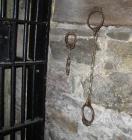
6
Handcuffs & Shackles were frequently used in transporting inmates to and from the York County Jail. Maximum security inmates might also be placed in shackles while in the exercise yard to prevent escape.Interview with Paul Wayne Stewart
Question - "What can you tell me about the use of handcuffs and leg irons and other means of restraining prisoners?"
Answer - "Well that certainly occurred, that was our only means of restraining somebody in the beginning. Towards the end mace and pepper spray did come in to the institution, but in the beginning if there was a confrontation or something physical going on within the cell, the other inmates that were in there would be cleared out and then two or three officers, whatever was necessary, would go in and have to subdue the guy that was causing all the trouble, doing the damage, and he would be handcuffed and, if necessary, shackled and moved down to segregation, and maybe kept that way for a temporary period of time 'til he kind of cooled down so he wouldn't do any harm to himself and those would be removed. During the transportation of offenders, if they were a remand or a security offender, that's how they would be moved from the institution. If they went out into the backyard and there was a security risk they'd either have handcuffs or shackles on so they couldn't escape or do something. If they were taken to the hospital, or the dentist, or wherever they had to be moved, they would go in those restraints based on their security. Now if he wasn't a security risk he could go without those restraints."
7
Lock and keys donated from the Dorchestor Penitentiary.24 September 2004
668 Brunswick Street, Fredericton, N.B
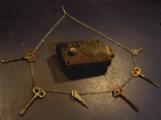
8
Locks - Prison doors were equipped with heavy locks. Here we have some typical keys.9
A picture of some of the unlabeled items found during recent excavations in the former exercise yard2 September 2004
668 Brunswick Street, Fredericton, N.B
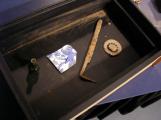
10
During the renovation of the exercise yard, several items were found buried in the earth. Your guess is as good as ours for some of these uncovered objects! In this picture there is a small bottle, a piece of a vase or plate, some type of picking tool and a 1923 New Brunswick Automobile Association ornament.11
More objects uncovered during the exercise yard excavations.2 September 2004
668 Brunswick Street, Fredericton, N.B
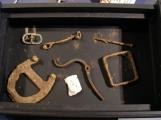
12
Here are some more objects which were uncovered during the renovation of the exercise yard. Under all that rust we can identify a horseshoe, what is possibly a horse bit, and an ankle lock, which might have been a piece of a whipping post. Also seen: a long nail, some type of buckle and a part of a vase or plate.13
A close up of a piece of the rope used in the Hamilton brother hangings.27 July 1949
668 Brunswick Street, Fredericton, N.B
